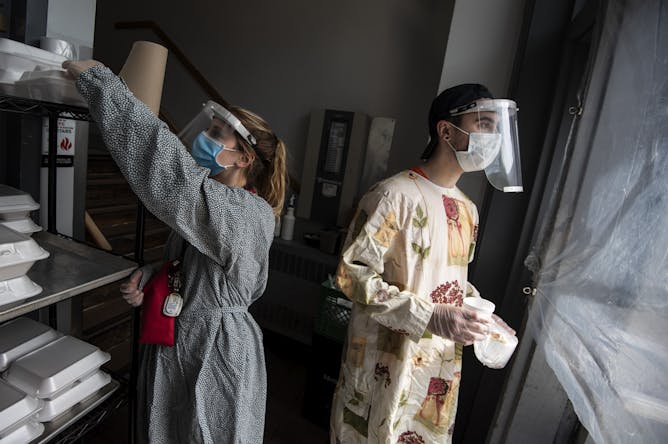|
|
|
|
Tiny moccasins, sneakers, sandals and traditional tobacco ties line the steps of public buildings across the country in honour of the 215 Indigenous children whose bodies were discovered at the former Kamloops Indian Residential school.
215 children.
Ground-penetrating radar was used to locate the children’s remains in a mass unmarked grave — the discovery reveals a macabre part of Canada’s hidden history.
Today in The Conversation Canada, Veldon Coburn of the Institute of Indigenous Research and Studies at the University of Ottawa talks about mourning the 215 children. He addresses how residential schools broke down and sterilized Indigenous lives, removing any trace of the gifts inherited from their parents and ancestors, re-packaging them into Canadian bodies.
Prof. Coburn writes about how until the remains were recently located, the Catholic church was content to leave 215 children as ‘disappeared,’ and how the disappeared — those that have been secretly disposed — produce a unique grieving.
Also today:
|
Haley Lewis
Culture + Society Editor
|

|
|
Today's Top Stories
|

People across Canada, including this scene in Edmonton, have left shoes and candles at public displays in recognition of the discovery of children’s remains at the site of a former residential school in Kamloops, B.C.
THE CANADIAN PRESS/Jason Franson
Veldon Coburn, L’Université d’Ottawa/University of Ottawa
Ground-penetrating radar located the remains of 215 First Nations children in a mass unmarked grave, revealing a macabre part of Canada’s hidden history.
|

Photographs of children killed in Gaza after Israeli strikes are held by demonstrators during a National March for Palestine in Washington, May 29. 2021.
(AP Photo/Jose Luis Magana)
Aparna Mishra Tarc, York University, Canada
As Israel and Egypt enter into discussions about a truce with Hamas, Palestinian children's thoughts and feelings on the conflict must be heard.
|

Endometriosis awareness has skyrocketed over the last decade thanks to social media use, and this brings both new resources and challenges for those living with the disease.
(Shutterstock)
Eileen Mary Holowka, Concordia University
Histories of mistreatment and misdiagnosis of endometriosis has led people dealing with the disease to turn to the internet for information and community.
|

Macular degeneration can result in blurred or no vision in the center of the visual field.
(Shutterstock)
Langis Michaud, Université de Montréal
Age-related macular degeneration (AMD) lives up to its name: Its prevalence increases with age and it is the leading cause of blindness in people over 65 years old.
|

How would you feel seeing more Canadian content on your ‘for you page’?
(Unsplash/Olivier Bergeron)
Robert Diab, Thompson Rivers University
Powers in Bill C-10 will force YouTube and TikTok to make CanCon more discoverable, skewing our searches and streams — but it’s unconstitutional.
|

Staff members wear gloves, face shields and gowns as they hand out meals at lunchtime at the Shepherds of Good Hope soup kitchen in Ottawa in 2020.
THE CANADIAN PRESS/Justin Tang
Brady Reid, University of Guelph; Lou Helps, University of Guelph
Canadians should consider place-based giving, or donating 'at home,' through local community foundations that are well-positioned to navigate and bolster the post-pandemic recovery.
|
La Conversation Canada
|

Apprendre à interagir uniquement par réseaux interconnectés, à distance, voilà la réalité qu'a imposée aux étudiants universitaires la pandémie de Covid-19.
Alexandra_Koch/Pixabay
Arnaud Francioni, McGill University; Alexia Pilon Diabaté, Université du Québec à Montréal (UQAM); Fèmy Fagla, Université du Québec à Montréal (UQAM)
En pleine pandémie, des étudiants universitaires ont organisé un évènement virtuel et multidisciplinaire. Il a été ainsi possible de casser certaines barrières physiques et institutionnelles.
|

Les dispositifs portables, comme les téléphones intelligents, deviennent omniprésents et constituent un danger au volant.
Shutterstock
Pierre-Majorique Léger, HEC Montréal; Sylvain Senecal, HEC Montréal
Les dispositifs portables, comme les montres intelligentes, sont de plus en plus utilisés. Mais ces appareils constituent une distraction dangereuse au volant.
|
Health
|
-
Rebecca Puhl, University of Connecticut
Negative attitudes about people with larger body sizes or higher weight are consistent across Australia, Canada, France, Germany, the UK and the US.
|
|
Culture + Society
|
-
Peter Terry, University of Southern Queensland
The tennis world paid attention when 13-year-olds were struggling with the pressures of turning pro. Osaka is reminding everyone that mental health concerns are still there.
|
|
Environment + Energy
|
-
Chloe Brimicombe, University of Reading; Hannah Cloke, University of Reading
Climate change has profound, but often overlooked, consequences for human health.
|
|
| |
| |
| |
| |
| |
| |
|
|
|
|
|
|
|